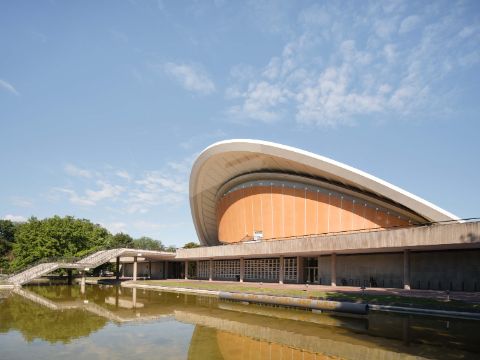The Building

Haus der Kulturen der Welt. Photo: Studio Bowie / HKW
The Site – In den Zelten
Haus der Kulturen der Welt (HKW) is located between Tiergarten, a large park originally designed as royal hunting grounds in the sixteenth century, and the government district, a cluster of buildings neighbouring the Reichstag along a stretch of land by the Spree river. HKW’s footprint overlaps with that of a square established in the 1780s known as In den Zelten (literally ‘in the tents’), named for the large tents erected by the ruling elite within Tiergarten. When the German revolutions took place between 1848 and1849, the site became a central gathering place for protestors to debate and organize.
By the time of the Weimar Republic, the area surrounding Tiergarten was a bustling district with a large Jewish population. In 1919, at In den Zelten 10, Dr Magnus Hirschfeld founded the Institut für Sexualwissenschaft (Institute for Sexology), the first of its kind in the world. Following the National Socialists’ ascent to power in 1933, looting and book burnings were rife in the area—Hirschfeld’s Jewish heritage, along with his support for the decriminalization of homosexuality and research into queer studies, became a target and the institute was forced to close the same year.
The district suffered heavily from aerial bombing raids during the Second World War, which damaged or completely destroyed nearly all of its buildings, while the majority of the Tiergarten’s trees were felled for fuel. After the war and the division of Berlin, the area was selected by the Senate of West Berlin to undergo regeneration as the site of Interbau, a development built for the 1957 Internationale Bauausstellung (International Building Exhibition, IBA).
The Building – the Kongresshalle
The building that is today home of HKW opened in 1957 as the Kongresshalle (congress hall). A gift to West Berlin from the United States government, it was designed by architect Hugh Stubbins as the contribution of the United States to Interbau. The Kongresshalle was built to the east of the main Interbau site, the Hansaviertel residential development. To realize the commission, the Benjamin Franklin Foundation was established under the chairmanship of Eleanor Dulles, sister of the then US Secretary of State, John Foster Dulles (after whom the street where HKW is located is still named).
Comprising an auditorium that could seat up to 1,000 visitors, as well as exhibition spaces, offices, and a restaurant, Stubbins’s modernist design was intended to facilitate a forum for the free exchange of ideas. The undulating form of the auditorium roof—built using engineering innovations up to then realized only in the United States—was said to be symbolic of freedom and democracy. Echoing these intentions, a quote from Benjamin Franklin invoking the ‘love of liberty’ and the ‘rights of man’ was engraved (in English and German) on the walls of the main foyer. The building’s architectural messaging was further emphasized by its proximity to the border of the Soviet sector and its placement upon an artificial mound to ensure wide visibility. The large concrete platform the auditorium sat upon doubled as a roof terrace, reachable via a freestanding stairwell flanked by a reflecting pool at the main entrance.
The Kongresshalle’s inaugural programme took place in September 1957 and was entitled The Old and the New World, exploring transatlantic relations and featuring contributions from, among others, the philosopher Theodor W. Adorno, the playwright Thornton Wilder, and the dancer and choreographer Martha Graham. In the two decades that followed, a broad range of cultural and political events took place at the venue, from 1962’s Music in the Technical Age, which featured thirteen experimental composers, to a meeting of Soviet dissidents in 1977. These activities were interrupted in 1980 when previous concerns about the structural integrity of the building’s design proved to be well founded. Part of the roof collapsed, killing a journalist, injuring several others, and destroying a large section of the terrace below. It was not until 1987 that repairs were completed and new safety regulations met in order for the building to reopen.
The Institution – Haus der Kulturen der Welt
Two years later in 1989, shortly before the fall of the Berlin Wall, Haus der Kulturen der Welt was established as a new centre for non-European cultures. The move to create a permanent venue with this purpose followed a series of events and exhibitions that had taken place over the previous decade under the umbrella of Horizonte – Festival der Weltkulturen (Horizons – Festival of World Cultures), first hosted by the Berliner Festspiele in 1979.
Previous general secretaries and directors of HKW:
Dr Günther Coenen, January 1989–June 1992
Dr Anke Wiegand-Kanzaki, June 1992–July 1996
Dr Hans-Georg Knopp, July 1996–December 2005
Prof Dr Bernd Scherer January 2006–December 2022
In January 2023, Prof Dr Bonaventure Soh Bejeng Ndikung assumed his role as Director and Chief Curator. Read more about the team and programme here.
For information on previous HKW projects and programmes, please visit: archiv.hkw.de.